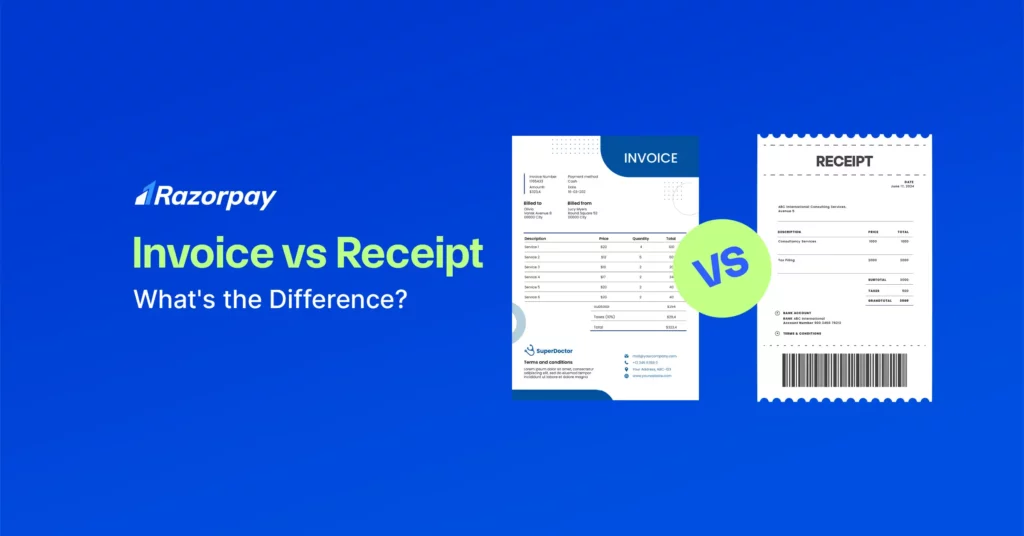Invoices and receipts are often confused, yet they serve distinct purposes in financial management. Understanding their differences is crucial for accurate record-keeping and streamlined operations. This article will clarify the roles of invoices and receipts, providing essential insights for business owners.
Table of Contents
Invoice vs Receipt: What is the Difference?
An invoice is a document issued by a seller to request payment for goods or services provided, while a receipt is given to confirm payment. Invoices outline what is owed, whereas receipts verify that the debt has been settled.
Parameter |
Invoice |
Receipt |
|
Purpose |
Request payment for goods/services |
|
|
Issued by |
Seller |
Seller or service provider |
|
Issued to |
Buyer |
Buyer |
|
Information Contains |
Details of goods/services, amount due, terms |
Details of payment made, date, amount paid |
|
Indicates |
Debt owed |
Debt settled |
|
Direction of Funds |
Buyer to Seller (Funds to be received) |
Buyer to Seller (Funds received) |
Related Reads:
- Purchase Order Vs. Invoices: What’s the Difference?
- What is the Difference Between Invoice and Bill?
What Is An Invoice?
An invoice is a formal commercial document issued by a seller to a buyer detailing goods or services provided, their corresponding costs, and payment terms. It serves as a request for payment and a comprehensive record of the transaction.
Invoices are typically generated post-delivery or service completion and are essential for accurate financial tracking and maintaining a clear transactional history.
Related Read: Invoice vs Contract: What’s the Difference?
How to Write an Invoice?
Writing an invoice is simple and easy, but it’s essential to include specific elements to document the transaction accurately and ensure prompt payment. These elements ensure that all necessary information is conveyed, making it easier for both the business and the customer to keep track of the transaction.
Related Read: How to Send an Invoice? A Step-by-Step Guide
Key Elements of an Invoice
Here are the key elements that you must include while preparing your invoice:
1. Invoice Header
- Clearly display the word “Invoice”
- Include a unique invoice number or reference code
- Specify the invoice date (date of issuance)
- Indicate the due date for payment
2. Seller Information
- Company name, logo, and contact details
- Business address
- Tax identification number (if applicable)
3. Buyer Information
- Customer name and contact details
- Billing address (if different from shipping address)
4. Itemized List of Goods or Services
- Detailed description of each item or service
- Quantity or units
- Unit price
- Total price per line item
5. Invoice Totals
- Subtotal of all items
- Applicable taxes (e.g., GST, VAT) itemized
- Discounts or adjustments (if any)
- Grand total due
6. Payment Terms
- Clearly state the payment terms (e.g., net 30 days)
- Specify accepted payment methods
7. Payment Information
- Bank details for electronic transfers
- Contact information for payment inquiries
8. Additional Information (optional)
- Purchase order number (if applicable)
- Shipping or delivery details
- Customer service contact information
- Terms and conditions
Including these elements is vital for clear communication with customers and facilitating timely payments, ultimately contributing to your business’s financial health.
Related Read: What is Invoice Reconciliation and How to Reconcile Invoices?
Create your Invoices with Razorpay Invoicing Software
What Is a Receipt?
A receipt is a crucial document issued by a business to verify a completed transaction. It serves as proof of purchase, detailing items acquired, the total amount paid, and the transaction date. Receipts are essential for maintaining accurate financial records and offer protection against disputes or return claims. By providing receipts for all payments, businesses demonstrate transparency, professionalism, and a commitment to customer satisfaction.
How to Write a Receipt?
Crafting a comprehensive receipt requires careful attention, despite its seemingly simple nature. A well-structured receipt effectively communicates transaction details, serving as a crucial document for both the buyer and seller.
Key Elements of a Receipt
1. Header
- Business name, logo, and contact information
- Receipt number or transaction ID
- Date of purchase
2. Customer Information
- Customer name (optional, but recommended for loyalty programs)
3. Itemized List
- Clear description of products or services
- Quantity purchased
- Unit price
- Total price for each item
4. Totals
- Subtotal of all items
- Applicable taxes and fees
- Discounts or promotions applied
- Grand total
5. Payment Information
- Payment method used
- Amount tendered
- Change returned (if applicable)
6. Footer
- Business address
- Return policy or warranty information (if applicable)
- Contact details for inquiries or returns
7. Additional Considerations
Clarity and Conciseness: Use clear language and avoid unnecessary information.
Professionalism: Maintain a clean and professional appearance.
Accuracy: Ensure all details are correct and consistent.
Legibility: Print or display information clearly for easy reading.
Providing comprehensive receipts is essential for fostering transparency and ensuring customer satisfaction, particularly when addressing transaction-related issues.
The Importance Of Invoices And Receipts In Business
1. Financial Control and Analysis
- Accurate financial recordkeeping: Comprehensive tracking of income and expenses.
- Effective expense management: Monitoring spending habits and budget adherence.
- Data-driven decision making: Utilizing historical data for strategic planning.
2. Tax Compliance and Optimization
- Simplified tax preparation: Streamlined process with organized documentation.
- Maximized tax deductions: Identifying eligible expenses for tax savings.
- Audit readiness: Providing necessary proof of transactions.
3. Operational Efficiency
- Improved cash flow: Timely invoicing and payment collection.
- Cost reduction: Identifying areas for cost-cutting through data analysis.
- Enhanced business performance: Making informed decisions based on financial insights.
How Razorpay Helps Businesses to Create and Manage Invoices?
1. Effortless Invoice Creation
With Razorpay, you can issue invoices directly from the Razorpay Dashboard or automate the process using API integration. This ensures invoices are generated automatically upon order placement, saving you time and reducing manual effort.
2. Seamless Payment Options
Offer your customers a variety of payment methods, including popular wallets and credit cards, directly on the invoice. This flexibility ensures faster settlements and improves your cash flow by providing a convenient payment experience.
3. Simplified Management
The Razorpay Dashboard gives you a centralized view of all your invoices. You can easily track the status of each invoice and download them as PDFs for easy record-keeping.
4. Customization Flexibility
Customize your invoices to match your brand identity and include detailed breakdowns of products or services. This clarity in communication helps maintain a professional image and ensures clients understand the charges.
Razorpay’s invoicing solution optimizes the entire process, saving you time and effort while delivering a professional and efficient client experience.
Conclusion
Distinguishing between invoices and receipts is crucial for effective financial management. While invoices represent a formal request for payment, receipts confirm successful transactions. Razorpay streamlines this process by providing customizable invoice templates and diverse payment options, enhancing your business’s financial efficiency and professional image.
Related Read: What is Invoice Price?
FAQs
1. Is an invoice the same as a receipt?
No, an invoice requests payment for goods or services, while a receipt confirms payment has been received.
2. Can an invoice be used as a receipt?
No, an invoice and a receipt serve different purposes and should be issued separately.
3. Can an invoice and receipt be combined?
No, they are distinct documents with separate functions and should not be combined.
4. Is an invoice number the same as a receipt?
No, invoice and receipt numbers are distinct identifiers for tracking different documents.
5. What comes first, an invoice or a receipt?
An invoice comes first to request payment. A receipt is issued after the payment is made.
6. What are the legal implications of an invoice and a receipt?
An invoice is a request for payment that can be used to enforce payment. A receipt is proof of payment, which is important for records and disputes.
7. Is it necessary to issue both an invoice and a receipt?
Yes, issuing both ensures clear communication and proper financial record-keeping for both parties.


